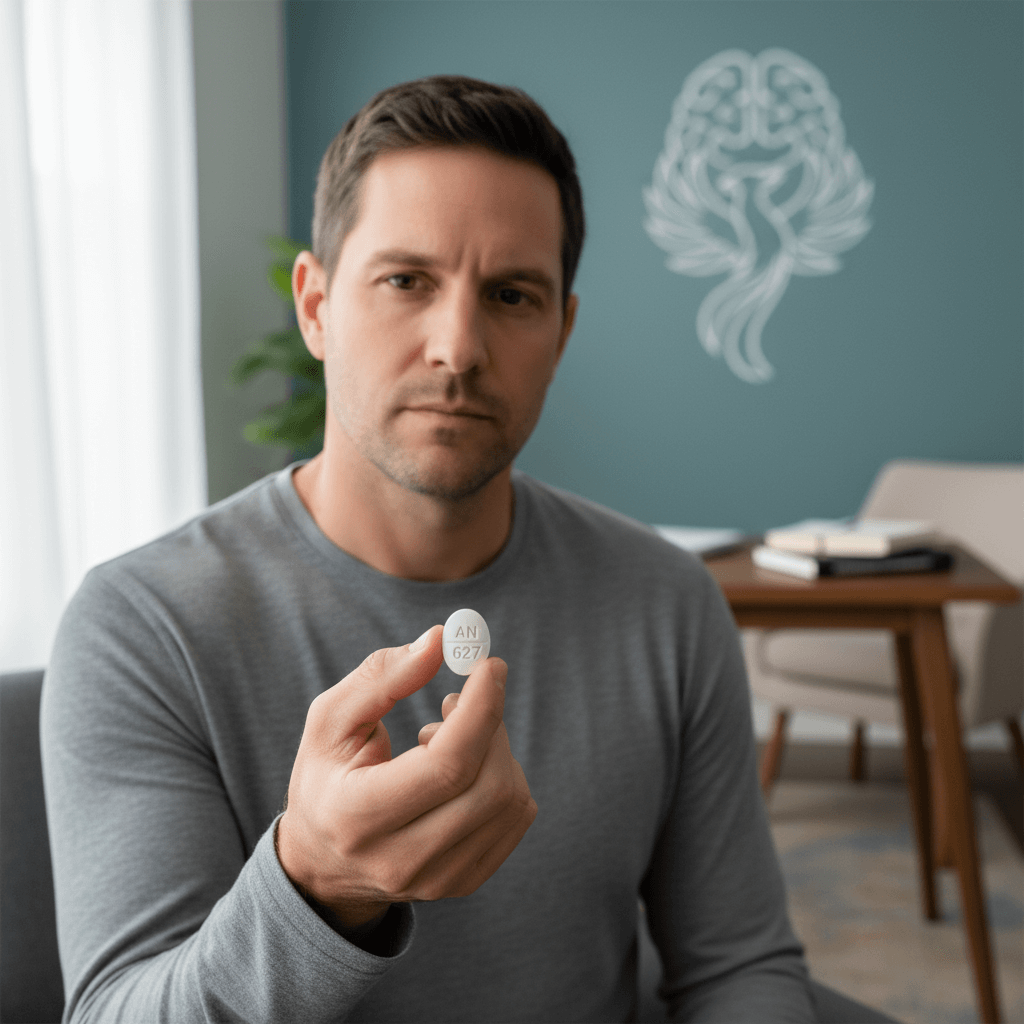Introduction: What is the White, Round Pill with "AN 627" on It?
Have you found a white, round pill with "AN 627" imprinted on it and wondered what it is? You're not alone. Many people discover unfamiliar medications in their medicine cabinets, purses, or even on the ground, leaving them with more questions than answers. This guide will provide you with crucial information about this specific medication and why proper identification matters.
The "AN 627" pill is identified as Tramadol Hydrochloride, 50 mg. It's a prescription opioid analgesic manufactured by Amneal Pharmaceuticals. The imprint "AN 627" serves as the medication's unique identifier, helping pharmacists, healthcare providers, and patients distinguish it from other similar-looking pills. This white, round tablet measures approximately 9 mm in diameter and has a slightly bitter taste if accidentally consumed.
Understanding what you're dealing with becomes especially important when it comes to opioid medications like tramadol. At Prescott House, we've seen firsthand how misidentified or misused medications can lead individuals down unexpected paths toward dependency. This article will cover the uses, dosage, potential side effects, and important safety information associated with the AN 627 pill to ensure its safe and effective use under medical supervision.

What is the AN 627 Pill Used For?
The AN 627 pill serves one primary purpose: managing moderate to severe pain in adults when other non-opioid pain relievers prove insufficient. Healthcare providers typically prescribe tramadol when over-the-counter medications like ibuprofen or acetaminophen fail to provide adequate relief, but before stronger opioids become necessary.
Common conditions treated with the AN 627 pill include post-surgical pain, where patients need reliable pain management during recovery periods. It's frequently prescribed for injuries such as fractures or severe sprains, where traditional pain relievers might not address the intensity of discomfort. Chronic conditions represent another significant use case, with arthritis and back pain sufferers often finding relief through tramadol when their condition flares up or becomes unmanageable with other treatments.
Neuropathic pain, which affects the nervous system itself, often responds well to tramadol's unique mechanism of action. This type of pain, which can feel like burning, shooting, or tingling sensations, doesn't always respond to traditional pain medications, making tramadol a valuable option for healthcare providers.
In some cases, doctors prescribe the AN 627 pill for off-label uses, though these applications fall outside its primary approved purposes. Some physicians may recommend it for restless leg syndrome or premature ejaculation, based on emerging research and clinical experience. However, these off-label uses should only occur under careful medical supervision and represent a small percentage of tramadol prescriptions.
How Does AN 627 (Tramadol) Work?
Tramadol's effectiveness comes from its unique dual-action mechanism, which sets it apart from other pain medications. Unlike traditional opioids that work solely through opioid receptors, tramadol takes a more comprehensive approach to pain management.
The medication binds to opioid receptors in the brain and spinal cord, effectively decreasing pain signal transmission. This opioid activity provides the immediate pain relief that patients seek. However, tramadol doesn't stop there. It also increases levels of serotonin and norepinephrine, two crucial neurotransmitters that naturally help block pain signals from reaching the brain.
This dual mechanism explains why some patients find tramadol effective when other medications fail. The combination of opioid activity and neurotransmitter modulation creates a more comprehensive pain management approach, particularly beneficial for complex pain conditions that involve both physical injury and nervous system dysfunction.
The onset of action typically occurs within 30 to 60 minutes after taking an AN 627 pill, with peak effects reached around two to three hours post-administration. The medication's effects generally last four to six hours, though individual variations in metabolism can affect both timing and duration. This relatively predictable timeline helps healthcare providers establish appropriate dosing schedules for optimal pain management.
Understanding tramadol's mechanism becomes particularly important when considering potential interactions with other medications. Because it affects serotonin levels, combining tramadol with other serotonin-affecting drugs—including certain antidepressants, migraine medications, or even some over-the-counter supplements—can lead to a dangerous condition called serotonin syndrome. This knowledge emphasizes why patients must maintain complete transparency with their healthcare providers about all medications and supplements they're taking.
Proper Dosage and Administration of AN 627
The typical starting dose for the AN 627 pill is 50 mg every four to six hours as needed for pain relief. However, dosing requirements vary significantly based on individual factors including pain severity, previous opioid exposure, age, kidney function, and overall health status. Healthcare providers carefully calibrate these variables to determine the most appropriate regimen for each patient.
For patients new to tramadol, doctors often recommend starting with a lower frequency to assess tolerance and effectiveness. Some individuals may begin with just 25 mg (half a tablet) every six hours, particularly elderly patients or those with compromised kidney or liver function. This conservative approach helps minimize side effects while allowing healthcare providers to gauge the medication's impact on the patient's pain levels.
The maximum recommended daily dose for tramadol is 400 mg in healthy adults under 65 years of age. For elderly patients or those with kidney or liver impairment, this maximum may be reduced to 300 mg or even lower. These limitations exist because tramadol accumulation in the body can lead to increased side effects and potentially dangerous complications.
Timing considerations play a crucial role in tramadol effectiveness. Taking the medication with food can help reduce nausea, a common side effect, though food doesn't significantly affect absorption. Patients should maintain consistent timing between doses to ensure steady pain control while avoiding the peaks and valleys that can occur with irregular dosing schedules.
At Prescott House, we've observed that many individuals struggling with prescription opioid dependence initially followed their prescribed dosing guidelines. However, as tolerance develops, some patients begin taking medications more frequently or in higher doses than prescribed, often rationalizing these changes as necessary for adequate pain control. This pattern represents one of the early warning signs that professional guidance may be needed.
Common Side Effects of AN 627
Understanding tramadol's side effect profile helps patients distinguish between normal medication responses and potentially serious complications requiring medical attention. The most frequently reported side effects affect the digestive system, with nausea occurring in approximately 25% of patients taking tramadol. This nausea often diminishes over time as the body adjusts to the medication, but it can be managed through timing adjustments or taking the medication with food.
Dizziness and drowsiness represent other common experiences, affecting roughly 15-20% of tramadol users. These effects can significantly impact daily activities, particularly driving or operating machinery. Patients should understand how tramadol affects them individually before engaging in activities requiring full alertness. The drowsiness typically peaks within the first few hours after taking the medication and may be more pronounced when first starting treatment.
Constipation, while less common with tramadol than with stronger opioids, still affects many patients. This occurs because opioid receptors exist throughout the digestive system, slowing intestinal movement. Patients can often manage this through increased fluid intake, dietary fiber, regular physical activity, and sometimes over-the-counter stool softeners recommended by their healthcare provider.
Headache and fatigue represent additional common side effects that may improve as the body adapts to the medication. Some patients also experience dry mouth, sweating, or sleep disturbances. These effects don't necessarily indicate a problem with the medication but rather normal physiological responses to tramadol's action on various body systems.
Less common but still noteworthy side effects include mood changes, anxiety, or confusion. These neurological effects can be particularly concerning for elderly patients or those with existing mental health conditions. Any significant changes in mood, thinking, or behavior should be reported to healthcare providers promptly for evaluation and potential medication adjustments.
Conclusion
The AN 627 pill—a 50 mg tramadol hydrochloride tablet manufactured by Amneal Pharmaceuticals—represents both an effective pain management solution and a medication requiring careful, informed use. Throughout this comprehensive guide, we've explored how this white, round pill works through its unique dual-action mechanism, providing relief for moderate to severe pain when other treatments prove insufficient.
Key takeaways from our discussion include understanding that tramadol's effectiveness comes from both its opioid receptor activity and its ability to enhance pain-blocking neurotransmitters like serotonin and norepinephrine. This dual mechanism makes it particularly valuable for complex pain conditions, including neuropathic pain that doesn't respond well to traditional pain relievers. However, this same complexity means patients must remain vigilant about potential drug interactions, especially with medications affecting serotonin levels.
The importance of following prescribed dosing guidelines cannot be overstated. Starting with the recommended 50 mg dose every four to six hours, with a maximum daily limit of 400 mg for healthy adults, helps ensure both effectiveness and safety. Common side effects like nausea, dizziness, and drowsiness are generally manageable and often improve as the body adjusts to the medication.
Perhaps most critically, recognizing tramadol as an opioid medication means acknowledging its potential for dependence and misuse. At Prescott House, we understand that the journey from prescribed pain management to problematic use often begins innocently, with patients simply seeking relief from legitimate pain. The transition from following prescription guidelines to taking medications more frequently or in higher doses can happen gradually, making it difficult to recognize when professional help becomes necessary.
If you're currently taking the AN 627 pill and have concerns about your usage patterns, or if you've noticed that your prescribed dose no longer provides adequate pain relief, these may be signs that it's time to have an honest conversation with your healthcare provider. Similarly, if you've found yourself thinking about the medication frequently, feeling anxious when supplies run low, or continuing to use tramadol beyond your prescribed treatment period, these experiences warrant professional attention.
For individuals who have developed a dependency on tramadol or other prescription opioids, recovery is not only possible but probable with the right support system. At Prescott House, we've witnessed countless individuals reclaim their lives from prescription opioid dependence through comprehensive, compassionate treatment approaches that address both the physical aspects of addiction and the underlying factors that contributed to substance use.
Remember that seeking help for prescription medication concerns doesn't mean you've failed or done anything wrong. Pain management and medication dependency represent complex medical issues that benefit from professional expertise and support. Whether you're a patient seeking to use the AN 627 pill safely or someone concerned about potential dependency issues, reaching out for guidance represents a positive step toward better health and wellbeing.
Your journey toward pain management—or recovery from prescription opioid dependence—doesn't have to be traveled alone. Professional support, whether from healthcare providers for safe medication use or specialized addiction treatment centers for dependency concerns, can make all the difference in achieving your health and wellness goals.
References
- What is the White Oval AN 627 Pill? - Renaissance Recovery
- AN 627 (Tramadol) Pill: Identification, Effects, and Addiction Risks - Recovered.org
- Pill Finder: AN 627 White Round - Medicine.com
Related Articles
- L484 Pill: Uses, Side Effects, and Identification Guide
- What Are M367 Pills? Analyzing the Uses and Risks
- AN 627 Pill Identifier: Uses, Side Effects, and Risks of This Tramadol Pill
- M365 White Oblong Pill: Uses, Side Effects, and Risks Explained
At Prescott House, Recovery Becomes Reality
Misusing prescription pills — including hydrocodone, oxycodone, Vicodin, Norco, and other opioid medications — can quickly lead to dependence, withdrawal symptoms, and escalating cycles of addictive behavior. At Prescott House in Prescott, Arizona, we help men break free from substance dependence through long-term, evidence-based treatment that addresses both addiction and co-occurring mental health issues.
Explore Our Specialized Programs:
- Long-Term Addiction Treatment for Men — Extended care and structured support designed for men seeking lasting recovery from opioid and prescription drug addiction.
- Substance Abuse Treatment — Comprehensive clinical care for alcohol and drug dependence, including prescription pain medication misuse.
- Gambling Addiction Treatment — Support for men struggling with compulsive gambling and accompanying behavioral challenges.
- Sex & Process Addiction Programs — Compassionate treatment for compulsive sexual behavior and pornography addiction.
- Dual Diagnosis Treatment — Integrated mental health and addiction treatment for anxiety, depression, trauma, and co-occurring disorders.
👉 Learn more about our programs →













